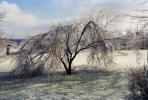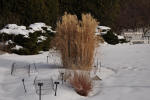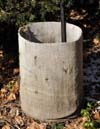|
 Since plants are "cold
blooded" life forms that depend on the heat of their
environment for energy, their internal chemical
processes are influenced by the temperature of their
surroundings. For those of us in the
temperate zones of
the world, the key climate factor of concern is cold
weather. Since plants are "cold
blooded" life forms that depend on the heat of their
environment for energy, their internal chemical
processes are influenced by the temperature of their
surroundings. For those of us in the
temperate zones of
the world, the key climate factor of concern is cold
weather.
In other climate zones of
the world, plant hardiness may be primarily a
consideration of heat, drought tolerance, soil
conditions, drainage, snow cover and other factors.
Although most people
would associate subfreezing temperatures with the term
"cold hardiness" however, plants are affected by several
factors in dealing with low temperatures including:
-
Cold Temperature - Most
cold hardiness ratings for landscape plants are
based on that plant's ability to live through some
level of cold temperatures. In this case, the
concern is for the freezing of the plant cells.
Unlike animals, plants have solid cell walls, if the
contents of the cell freezes and expands, it will
burst and die.
 Plants have developed mechanisms to help them
survive sub-freezing temperatures of the winter
months. Those from the tropics do not experience
freezes so they have no defense and may be damaged
by temperatures in the 30's. Other plants of the
arctic regions can survive temperatures of 40 below
zero or more. Plants have developed mechanisms to help them
survive sub-freezing temperatures of the winter
months. Those from the tropics do not experience
freezes so they have no defense and may be damaged
by temperatures in the 30's. Other plants of the
arctic regions can survive temperatures of 40 below
zero or more.
In the United States, the Department of Agriculture
(USDA) has developed a
cold hardiness map that shows the absolute
low temperatures experienced by the land area of
North
America. Horticulturists and gardeners have
categorized plants by the minimum temperature at
which they can survive and avoid serious cell
damage.
For example, a plant that can routinely survive
exposure to -10 to -20 degrees F are said to be
hardy to Zone 5 on the USDA map.

-
Temperature Fluctuations
- In addition to the absolute minimum cold
temperature, plants are
 also affected by
fluctuations in temperatures. As they adapt to the
seasons in the temperate zones, plants gradually
build their level of hardiness starting in the fall
and hitting their peak hardiness in the coldest
months of the winter. Then they gradually lose
hardiness as spring progresses. also affected by
fluctuations in temperatures. As they adapt to the
seasons in the temperate zones, plants gradually
build their level of hardiness starting in the fall
and hitting their peak hardiness in the coldest
months of the winter. Then they gradually lose
hardiness as spring progresses.
Therefore, a drop to 25 degrees in October or March
may damage buds and plant tissue more than a
temperature of -25 degrees in February. Warm periods
in the winter may cause plants to begin to lose
their hardiness and them be damaged by a return to
normal cold temperatures.

-
Desiccation - Another
impact of cold weather is that it can have a
dehydrating effect on plant tissue. Cold air tends
to hold less water i.e. humidity, than warm air so
winter winds can pull water out of the leaves or
needles of evergreens, buds and even stems.
 Broadleaf evergreens such as
rhododendrons,
boxwood,
wintercreeper and others tend to be impacted by this
factor more than deciduous plants which drop their
leaves. Often when you hear that a plant should be
placed in a "sheltered location", it means that it
needs to be protected from winter winds and their
drying effect. Broadleaf evergreens such as
rhododendrons,
boxwood,
wintercreeper and others tend to be impacted by this
factor more than deciduous plants which drop their
leaves. Often when you hear that a plant should be
placed in a "sheltered location", it means that it
needs to be protected from winter winds and their
drying effect.
Also a factor in winter damage through desiccation
is the position of the sun in relationship to the
plant. In most temperate zones, the strongest winter
sun comes from the south or southwest. Even on very
cold days, if the sun is out, it may warm the
surface layer of the leaves of evergreens and cause
them to loose water.

|



